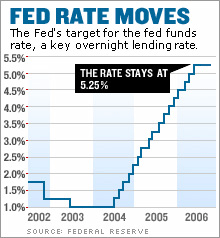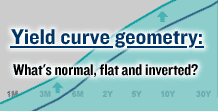The Fed's pregnant pauseFew expect Ben Bernanke & Co. to change interest rates at its first meeting of the year - and some are starting to think the Fed may stand pat for all of 2007.NEW YORK (CNNMoney.com) -- The Federal Reserve is widely expected to leave a key short-term interest rate unchanged for the fifth consecutive time when it wraps up a two-day meeting on Jan. 31. But Wall Street will be keeping a close eye on the Fed's policy statement for any hints regarding the timing of a long-awaited rate cut. 
The Fed started deliberations in its first meeting of the year at about 2 pm EST Tuesday, Reuters reports. According to interest rate futures listed on the Chicago Board of Trade, investors are pricing in a 98 percent chance that the nation's central bank will keep the federal funds rate, a key rate that affects what consumers and businesses pay on various types of loans, at 5.25 percent. The Fed had raised interest rates by a quarter of a percentage point for 17 consecutive meetings between June 2004 and June of last year to keep inflation in check. Since the Fed first paused last August, many investors have been hoping that the central bank would soon start cutting interest rates in order to make sure that the economy does not fall into a tailspin. Although interest rates are still relatively low by historical standards, some fear that as a result of the previous rate hikes, consumers and corporations will eventually cut back on spending, which could have a drastic effect on the economy. To that end, traders are pricing in a 2 percent chance that the Fed may lower interest rates by a quarter of a percentage point. But several Fed members, including chairman Ben Bernanke, have indicated in recent speeches that they are still concerned about inflation. The minutes from the Fed's last meeting, held in December, also demonstrated that the Fed is keeping a close watch on pricing pressures. Steady, for a while With that in mind, there is a growing sense that the Fed may keep rates at 5.25 percent for the foreseeable future, even though energy prices have retreated lately, easing some inflation concerns. "It's going to be steady as she goes, which is essentially the Fed saying that inflation trends are lower but the risks are still to the upside," said Keith Hembre, chief economist with First American Funds in Minneapolis. "I think the Fed's on hold for the next six months." David Kelly, senior economic adviser with Putnam Investments in Boston, goes one step further. He thinks the Fed will keep rates at 5.25 percent throughout 2007. Kelly argues that the Fed no longer has to worry that much about inflation thanks to lower oil prices, and that recent signs of strength in the housing market should put to rest fears of a severe economic slump. "What must be comforting to the Fed is that the danger of a recession has receded and the danger of inflation has also receded, so the landing strip for a soft landing just got a lot longer," said Kelly. "Oil prices have come down a lot from their peak and housing appears to be stabilizing." Still, economists said the Fed is likely to continue to talk tough about inflation. So there probably won't be any significant changes to the statement that the Fed releases Wednesday. Economists expect the Fed to acknowledge the pullback in energy prices but also point out that there still is a long-term threat from inflation. But even if the Fed maintains its hawkish stance, some economists think it's just for show. What's more, one of the Fed's biggest inflation hawks, Richmond Federal Reserve Bank President Jeffrey Lacker, is not a voting member of the Fed's policy committee this year. Lacker was the lone voice of dissent during the Fed's past four meetings, voting in favor of a rate hike. So at this meeting, a unanimous vote for no change in rates is expected. "There is reason for the Fed to be relaxed but they won't let their guard down," said James Glassman, senior economist with JP Morgan Chase. "The language may imply a tightening in the future, but it's more for the record, a reminder that, with the economy where it is, the Fed has to be more wary of the potential inflation threat." Unemployment outlook In addition to lower energy prices, many economists predict that the unemployment rate will inch higher this year, which could make inflation even less of a concern. That's because labor costs represent the highest percentage of corporate expenses. So a robust job market tends to lead to more inflation pressure as businesses may seek to pass off the higher expenses onto consumers. But the unemployment rate is not expected to head much higher in the near future. The unemployment rate stood at 4.5 percent in December and economists are forecasting that it remained at that level in January. The January labor figures will be reported by the government on Feb. 2. With all this in mind, the Fed may now find itself in an unusually comfortable position of not having to worry too much about the health of the economy. Unless energy prices spike again during the summer or the housing market takes a sudden turn for the worse, the Fed could be faced with an economy that is growing at a modest pace without any major inflationary concerns. That could mean that the Fed will not just keep interest rates steady in 2007 but throughout next year as well. "The Fed may stay on hold indefinitely. We would need to see some change in economic expectations in either direction that are more substantial than we've seen so far," said David Resler, chief economist with Nomura Securities International. "We went through a nearly two-year stretch in the early 1990s with no change in Fed policy and we could be heading into the same kind of period." Nonetheless, several economists said that when the Fed finally does decide to make a change to interest rates, the next move is likely to be a rate cut. "Eventually the Fed will cut, but not because the economy is weak. The Fed can back off once inflation threats have drifted downward, and that's not going to happen until at least the second half of the year," said Glassman. |
| |||||||||



